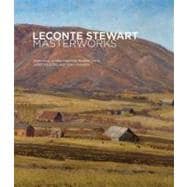
The New copy of this book will include any supplemental materials advertised. Please check the title of the book to determine if it should include any access cards, study guides, lab manuals, CDs, etc.
The Used, Rental and eBook copies of this book are not guaranteed to include any supplemental materials. Typically, only the book itself is included. This is true even if the title states it includes any access cards, study guides, lab manuals, CDs, etc.
LeConte Stewart's art education began while he was a young student attending Richfield Elementary School inRichfield, Utah. With the conclusion of classwork each day, he would hurry home to collect paper and pencil, and thendash to the banks of Spring Ditch. In seclusion, seated on a clump of dry grass, he practiced sketching directly from nature while observing the shapes and structures of willows, bull berry, and wild currant bushes. With each visit, he meticulously observed nature's changes during the day and with each season.
A no-nonsense attitude dominated the small, struggling community during LeConte's childhood. At that time, the fine arts were not understood and pursuit of a professional art career was openly derided. While few understood LeConte's interest in drawing, his teacher Sophia Gulbranson recognized his unique ability and encouraged him. On special occasions she urged him to draw on the blackboard with colored chalk for the class. "It was an exciting and new experience for me," LeConte recalled. From her quiet reassurance he knew it was right to keep working at his art, despite the fact that other teachers and the school principal ignored his skill 1 and, he noted, "There was really nothing in Richfield to inspire a young artist." 2 During the dry summer and winter months, endless miles of gray sagebrush, rabbitbrush, and greasewood dotted the ashen valley floor and surrounding hills. "The Richfield landscape created a negative impression on me until my father took me with him in his one-horse buggy to neighboring villages throughout Sevier County. 3 LeConte's father, Isaac, was a lawyer who traveled within the district to visit his clients. It was anew experience for LeConte, and upon approaching one town he observed a little house, a cottage hidden by trees, and he remembered being intrigued and moved by the scene. Throughout his travels he saw barns and rustic cattle sheds, some maintained with pride and others unkempt through neglect or hard times. LeConte absorbed the images from his childhood, the blue-green sagebrush spreading over plains and hills, and that house nestled in the trees. With these memories he experienced a peculiar isolation, an indescribable loneliness, "which all my life I have yearned to putdown in paint." 4 Contributing to the loneliness that young LeConte experienced was a devastating series of deaths within his family: his mother, Anna, and her new baby girl, as well as other younger brothers and sisters of his. Various children's diseases as well as accidents were ever-present.